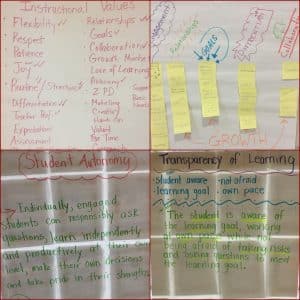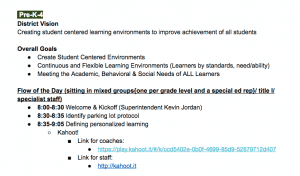The Importance of Modeling Student-Centered Professional Learning
CompetencyWorks Blog
This post originally appeared at Students at the Center on July 7, 2017.
Creating student-centered learning environments is no easy task. Teachers often do not receive enough quality professional learning to provide them with the time to design student-centered learning environments. The major difficulties are that they lack the opportunity to actively provide choice and voice in their school systems and they are put under too much pressure to meet curriculum and assessment needs based on statewide testing mandates. In short: professional learning doesn’t often “practice what it preaches.”
Case in point, not long ago I sat through a workshop on differentiation with 300 of my colleagues, while a presenter shared the same information, in the same way, with us all day about how to tailor instruction for different students’ needs. Professional learning opportunities must be intentionally designed to show instructional-strategies-in-action, allowing educators to experience what student-centered learning looks and feels like. Period. If the goal of the school and/or district is to transition to a student-centered and personalized model, where transitioning can be messy and difficult, and requires the burden of the learning to be put onto the shoulders of the learner (while the educator maintains the role of the environmental facilitator and learning certifier), then professional learning environments must mirror those same design aspects. The realization of this need brought about the recent professional learning workshop focused on student-centered learning held by the Maine School Administrative District #46 (a part of Alternative Organizational Structure #94 [MSAD#46/AOS#94]). Here’s how it was designed:
STEP 1: LISTEN TO YOUR LEARNERS
As one of the organizers of the workshop1, I did some data collection using a Professional Learning Needs Survey several weeks before the workshop. I had also been engaging in conversations and listening to teachers struggle with the many challenges they face with student engagement, students’ mental health challenges, ensuring equity for all students, progress monitoring, and more. After listening, hearing, and attempting to understand the challenges facing our teachers daily, the Professional Learning Needs Survey encouraged our staff to rank topics (highest need, moderate need, low need, and no need) in the following areas:
- Student-Centered Learning
- Proficiency-Based Grading and Reporting
- Student Engagement
- Special Needs
- Technology Integration
- Teacher Evaluation
Understanding that different grade spans and grade levels have different struggles and needs,we looked at those data through multiple lenses:
- Pre-K-4
- 5-8
- 9-12
- Pre-K-8
- 5-12
- Pre-K-4, 9-12
- Pre-K-12
Breaking down the data this way helped us uncover common areas of need from a district level all the way down to a grade-span level, and helped us to create environments and opportunities for our teachers to solve the problems that they face.
STEP 2: EMPOWER, EMBOLDEN, AND ENERGIZE
Based on the survey data, the staff was separated into two different groups: Pre-K-4 and 5-12. Guided by the instructional coaches, the Pre-K-4 group’s teachers used a design thinking process to restructure the way they “do” Pre-K-4 school—specifically, how we “group” students. Traditionally, Pre-K-4 students are grouped by age, but our teachers have been facing challenges like meeting the needs of all learners effectively. So, the teachers came together to design something new, and thankfully the administration said, “Go for it.” These sessions included settling on common language for “student-centered,” “continuous and flexible grouping,” and “meeting the needs of all learners,” as well as developing common instructional and personal educational values.

The teachers were given the entire day to collaborate, dream, problem-solve, and design, and were not rushed through this process, because it was clear that without a common language, nothing effective could be designed. By the end of the day, the staff had developed proposals that are going to the building leadership and administrative teams to be put into effect for the 2017-2018 school year.

The staff in grades 5-12 wanted to focus on curriculum and assessment, and to collaborate on similar challenges. Their PD was designed to be an “(un)conference”—a more flexible model of professional learning. The morning was organized by content areas, and they worked together to align curriculum and assessment, and shared grading and reporting strategies (the state of Maine has recently shifted to proficiency-based education). There were no outside experts brought in, or expected tasks. Instead, groups were given these goals to achieve, with the freedom to decide how to attain them:
- Identify accuracies and inaccuracies of standards, assessments, and instruction at classroom, grade-level, and content area
- Develop and share prototypes of common reporting mechanisms and strategies to improve student achievement and learning.
Given the precious gifts of time, collaboration, and trust to name the problems of practice they were grappling with and to develop (and own) the solutions, our teachers came out of the workshop with a better understanding of what to do next, equipped to tackle challenges, and energized to perform better and be happier in the classroom. Sounds just like the outcomes we would want for our students from student-centered learning, right?

STEP 3: LEARNER-FIRST MINDSET
MSAD#46/AOS#94 is focused on providing its professional staff with a simple goal: create student-centered learning environments to improve the learning and achievement of all students. To build the culture of learning, intrinsic motivation, and ownership of quality education in our schools, professional learning opportunities for our staff must be designed, implemented, and reflected upon using the same methods a teacher would use in a student-centered classroom.
We are currently in the throes of planning for next year, based on the data, feedback, and ideas presented to us from this workshop. It wasn’t all perfect. There were many 5-12 teachers who were frustrated by the seeming “lack of leadership” in the sessions. While it may have been frustrating at the time, this is an important experience, as they are beginning to feel what the students feel when we begin to unravel the tangled web of learned helplessness we have unintentionally instilled in them during their schooling. The staff are beginning to understand that compliance is not the same as engagement, and that instead of looking for someone to give them the answer, they are empowered to lead and to be the experts we all know they are. The staff are learning the power and the feeling of true empathy for our students, and there is no more powerful change agent in the world than a motivated educator.
1For the design of the workshop, I worked closely with instructional coaches (fondly called ‘Team #Awesomesauce’) to build the flow and structure of the workshop to best meet the personalized needs of the learners. I developed the survey based on prior PD data, observations, copious amounts of research of best practices, and lots and lots of conversations with teachers and administrators. Throughout the day I took a backseat approach because the teachers, plainly, needed the time to connect and collaborate and the structure in which to flourish. I am evaluating the data from the workshop day and, with the administrative team, school leadership teams, the district professional learning team, and the aforementioned Team #Awesomesauce, will continue to work toward building a learner-centered culture for everyone within the MSAD #46/AOS #94 educational community.
See also:
- Lessons from a Social Studies Teacher: Work Study Practices Matter in a Competency-Based High School
- Competency-Based Learning Centers
- National Summit on K-12 Competency-Based Education Recommended Reading
Matt Drewette-Card has been the Director of Curriculum-Instruction-Assessment for AOS #94 since 2012. He is recognized as a visionary leader in Maine’s transition to a proficiency-based learning system, technology integration, educator effectiveness, creative and effective instructional techniques, and design thinking. He is one of the #EdChatME Design Team members (Twitter), co-founder of MooseCamp, and a school board member for MSAD #75.